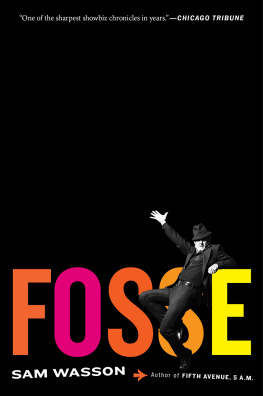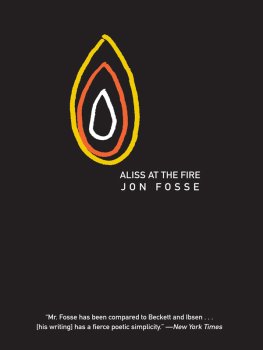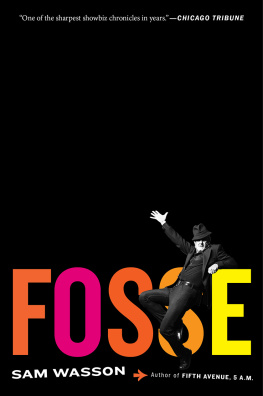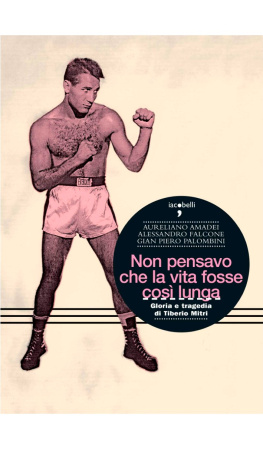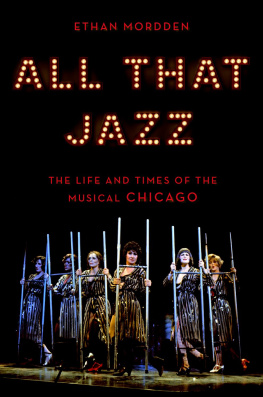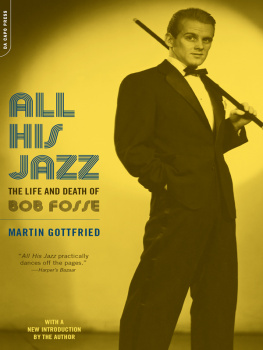First Mariner Books edition 2014
Copyright 2013 by Sam Wasson
All rights reserved
For information about permission to reproduce selections from this book, write to or to Permissions, Houghton Mifflin Harcourt Publishing Company, 3 Park Avenue, 19th Floor, New York, New York 10016.
www.hmhco.com
The Library of Congress has cataloged the print edition as follows:
Wasson, Sam.
Fosse / Sam Wasson.
pages cm
An Eamon Dolan Book.
ISBN 978-0-547-55329-0 (hardback) ISBN 978-0-544-33461-8 (paperback)
1. Fosse, Bob, 19271987. 2. ChoreographersUnited StatesBiography. I. Title.
GV1785.F67W37 2013
792.8'2092dc23
[B]
2013026082
Cover design by Martha Kennedy
Cover photograph Norman Seeff
e ISBN 978-0-547-99922-7
v3.0316
I Wanna Be a Dancin Man by John H. Mercer and Harry Warren 1951, 1952 Warner Chappell Music, Inc. 2013: Used by Permission of the Johnny Mercer Foundation, Inc.
For this books family:
David Halpern
George Hodgman
Eamon Dolan
and Genevieve Angelson
How much time do I have?
Bob Fosse
The End
G WEN VERDON, LEGALLY Mrs. Bob Fosse, was smiling big. She had perched herself in the foyer beside a tray of champagne flutes so that, with the help of a few servers, she could pass them out between air-kisses and the occasional embrace. Verdon held herself with a poise befitting her legacy as the one-time greatest musical-comedy star in the world, and though her glory days were far behind her, one could immediately recognize the naughty, adorable, masterfully flirtatious song-and-dance girl Broadway had fallen in love with. Fosses best friend, Paddy Chayefsky, had called her the Empress.
Around eight oclock, the flurry of famous and obscure, some of them in black tie, others dressed merely for a great time, hugged and kissed their way off the pavement and into Tavern on the Green. They passed Verdon as they headed down the mirrored hall to the Taverns Crystal Ballroom, a fairy-tale vision of molded ceilings and twinkling chandeliers where light was low and sweet and a dark halo of cigarette smoke hovered over the ten-piece band. They played before a wide-open dance floor and dozens of tables apoof with bouquets. Each place was set with a miniature black derby, a tiny magic wand, and a little toy box that, when opened, erupted with cheers and applause.
For Fosses haute clique of friends, lovers, and those in between, the night of October 30, 1987, was the best worst night in show-business history. In work or in love, they had all fought Fosse (in many cases, they had fought one another for Fosse), and they had always come back. No matter the pain he caused, they understood that on the other side of hurt, grace awaited them. His gifttheir talentawaited them. But now that Fosse was deadthis time permanentlymany wondered how his wife, daughter, and armies of girlfriends, separated by their own claims on his love, would learn to hold his legacy.
The site of sundry Fosse movie premieres and opening-night bashes, Tavern on the Green had hosted the oddest pairings of writers, dancers, and production people, old and young, sober and drunk, but tonight, the dance floor seemed to scare them away.
People talked in separate clusters. Liza Minnelli cut a line through the procession, squeezed Verdons hand, and made her way toward Elia Kazan. Then came Roy Scheider. Without stopping, he nodded at Verdon and eased past Fosses agent, Sam Cohn, who was wallflowering by Fosses psychiatrist, Dr. Clifford Sager, and Alan Heim, editor of Fosses autobiographical tour de force All That Jazz. Alan, producer Stuart Ostrow said, you know, Bob always said you edited his life. There was Cy Coleman; Sanford Meisner; Buddy Hackett; Dianne Wiest; Herb Schlein, the Carnegie Deli matre d who kept linen napkins set aside for Bobby and Paddy, his favorite customers for twenty years. Where was Fosses ally and competitor Jerome Robbins? (He was free that night, though hed RSVPd no.) Peering into the crowd, Verdon spotted what remained of Fosses closest friendsHerb Gardner, E. L. Doctorow, Neil Simon, Steve Tesich, Peter Maas, Pete Hamillall writers, whom Fosse idolized for mastering the page, the one act he couldnt. They were slumped over like tired dancers and seemed lost without Paddy, Lancelot of Fosses Round Table. If there is an afterlife, Gardner said, Paddy Chayefsky is at this moment saying, Hey, Fosse, what took you so long?
Before his cardiac bypass, Fosse had added a codicil to his will: I give and bequest the sum of $25,000 to be distributed to the friends of mine listed... so that when my friends receive this bequest they will go out and have dinner on me.
Fosse thought the worst thing in the world (after dying) would be dying and having nobody there to celebrate his life, so he divided the twenty-five grand evenly among sixty-six peopleit came out to $378.79 eachand then had them donate that money back to the party budget so that theyd feel like investors and be more likely to show up. Bob Fossethe ace dancer, Oscar and Tony and Emmy Awardwinning director and choreographer who burned to ash the pink heart of Broadway, revolutionized the movie musical twice, and changed how it danceddied hoping it would be standing room only at his party, and it was. Many more than his intended sixty-six shouldered insome thought over two hundred came that nightbut after a lifetime in show business, having amassed a militia of devoted associates, he had not been sure they all really really loved him. Had he been there, Fosse would have been studying their faces from across the room, keeping track of who told the truth and who told the best lies. Who really missed him? Who pretended to? Who was acting pretentious? Who was auditioning? He would have called Hamill and asked him later that night, waking him up, probably, at two in the morning. Fosse would fondly and faithfully deride the bereaved, but underneath hed be worrying about the house, how many came, where they laughed, and if they looked genuinely sad.
This is incredibly sad, said Arlene Donovan on one side of the room.
Im having the best time, said Alan Ladd Jr. on another.
Roy Scheider, who had played a version of Fosse in All That Jazz, scrutinized every detail of the party scene from behind his cigarette and said, It was as if he was orchestrating it. He laughed.
Stanley Donen eyed Scheider. My God, Donen thought, Im watching this with Fosses ghost.
By midnight many had said their goodbyes, but you wouldnt know it to hear the band, grooving hard on their second wind. Ties were loosened. High heels dangled from fingers. Only the inner circle remained. Here was Fosses daughter, Nicole. Here was Gwen Verdon, his wife. Here was Ann Reinking, Fosses friend and girlfriend of many years. Along with his work, they were the living record of his fervor, adored and sinned against, difficult to negotiate, impossible to rationalize.
In a quiet room away from the clamor, Fosses last girlfriend, Phoebe Ungerer, wept. Then she left.
Suddenly Ben Vereen flew to the dance floor. He threw his hands into the air and then onto his hips and started slithering. At first he was alone, but moments later the crowd caught on. Reinking followed with Nicole and the eternal redhead, Nicoles mother, the Empress. The bandleader upped the tempo to a funk sound with the kind of heavy percussion Fosse loved, and Fosses three women moved closer together. Verdon, sixty-two; Reinking, thirty-eight; and Nicole, twenty-fourwife, mistress, daughterstarted swaying, their arms entwined, moving together in an unmistakably sensual, sexy way. Their eyes closed and their bodies merged with the beat, pulsing together, like a hot human heart. Others joined them. First ex-girlfriends, then writers. A circle formed, closing in around the women, then opened, then closed, ceaselessly breaking apart and coming together. Grief and laughter poured out of them in waves.
Next page
